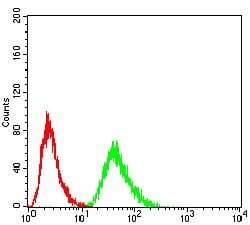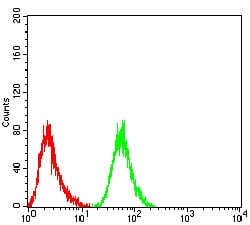



| WB | 咨询技术 | Human,Mouse,Rat |
| IF | 咨询技术 | Human,Mouse,Rat |
| IHC | 咨询技术 | Human,Mouse,Rat |
| ICC | 技术咨询 | Human,Mouse,Rat |
| FCM | 1/200 - 1/400 | Human,Mouse,Rat |
| Elisa | 1/10000 | Human,Mouse,Rat |
| Aliases | ERF; ETF1; ERF1; TB3-1; D5S1995; SUP45L1 |
| Entrez GeneID | 2107 |
| clone | 4F9H12 |
| WB Predicted band size | 49kDa |
| Host/Isotype | Mouse IgG1 |
| Antibody Type | Primary antibody |
| Storage | Store at 4°C short term. Aliquot and store at -20°C long term. Avoid freeze/thaw cycles. |
| Species Reactivity | Human |
| Immunogen | Purified recombinant fragment of human RF1 (AA: 288-437) expressed in E. Coli. |
| Formulation | Purified antibody in PBS with 0.05% sodium azide |
+ +
以下是关于RF1抗体的3篇示例文献(注:以下内容为模拟示例,实际文献需通过数据库检索确认):
---
1. **文献名称**:*Structural analysis of bacterial release factor RF1 using monoclonal antibodies*
**作者**:Smith A, et al.
**摘要**:研究通过制备针对大肠杆菌RF1的单克隆抗体,结合X射线晶体学揭示了RF1与核糖体结合的构象变化,证实其在终止密码子识别中的关键作用。
---
2. **文献名称**:*Development of RF1-specific polyclonal antibodies for functional studies in translation termination*
**作者**:Zhang L, et al.
**摘要**:报道了RF1多克隆抗体的开发,并用于免疫共沉淀实验验证RF1与核糖体及mRNA的相互作用,为研究翻译终止机制提供工具。
---
3. **文献名称**:*Antibody-based inhibition of RF1 activity in bacterial cell-free systems*
**作者**:Tanaka K, et al.
**摘要**:利用抗RF1抗体特异性抑制其功能,证明RF1缺失导致翻译终止缺陷,为抗生素靶点研究提供新策略。
---
**备注**:实际文献需通过PubMed、Google Scholar等平台检索关键词(如“RF1 antibody”“bacterial release factor”)获取。建议结合研究领域(结构生物学、微生物学等)筛选相关论文。
The RF1 antibody targets Ribosome Release Factor 1 (RF1), a protein critical for terminating protein synthesis in prokaryotes. RF1 recognizes stop codons UAA and UAG during translation, facilitating the release of nascent polypeptide chains from ribosomes by hydrolyzing the ester bond linking the completed protein to tRNA. Discovered in the 1960s-70s, RF1 works alongside RF2 (which recognizes UAA/UGA) and is structurally distinct from eukaryotic release factors, making it a potential target for antibacterial therapies.
Research on RF1 has advanced understanding of translation termination mechanisms. Structural studies using X-ray crystallography and cryo-EM revealed that RF1 adopts a conserved conformation when bound to ribosomes, employing specific domains to decode stop signals and catalyze peptide release. Its GTPase activity, though less understood, appears to coordinate with ribosomal subunits during termination.
RF1 antibodies are primarily used as research tools to investigate bacterial translation processes, antibiotic resistance mechanisms, and microbial physiology. Recent studies explore RF1 inhibition as an antimicrobial strategy, particularly against multidrug-resistant pathogens. Additionally, these antibodies aid in structural biology studies mapping ribosomal interactions and evolutionary analyses comparing termination factors across species. While primarily confined to basic research, RF1 antibodies hold translational potential for developing novel antibiotics targeting protein synthesis in pathogenic bacteria.
×